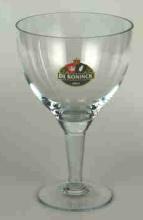A Beginner's Guide to Belgian Beer
For such a small country, Belgium has an astonishingly wide range of breweries and beer styles. Add to this the fact that the number of different beers carried in many bars are often numbered in the hundreds (for example,
Kulminator in Antwerpen lists over 400 beers on its menu) and someone new to Belgian beer can easily feel overwhelmed by the choice available. It's not for nothing that the Confederation of Belgian Brewers describes the country as "Beer Paradise."
One note of caution: Belgian beers are usually
much stronger than British ones. You might be used to drinking beer that's say 3.5% to 5%, but in Belgium you'll find that 5% is one of the weaker beers. 7% or 8% are common and even 10% or 11% isn't exactly rare. Fortunately you'll usually be served smaller amounts of beer than your normal pint, but do please take care.
This is not intended to be an exhaustive guide to Belgian beer (but see
further reading for suggestions) rather an introduction to get the first-time visitor to Belgium started on the world's most wonderful beer culture. The author doesn't claim any great expertise on the subject, merely an enthusiasm for Belgium and its beers and a desire to introduce others to the pleasures of this wonderful country.
Fortunately, these days it isn't always necessary to visit Belgium to taste the country's wonderful beers. Many British pubs and supermarkets now sell at least a small range of Belgian beers. However, the number of beers which make it out of the country on a regular basis represents only a small proportion of what can be found in Belgium. Once you've got a taste for Belgian beer, there's no substitute for a trip over to enjoy it on its home ground.
A note on languages:
Belgium has three officially recognised languages, Flemish (almost, but not quite, identical to Dutch) spoken by 70% of the population, French, spoken by 25% and German, spoken by 5%. Although they are a generally laid-back people, Belgians tend to be
very chauvinistic where their language is concerned; using the wrong one will often be taken as being very offensive. Fortunately the linguistic divide is, with the exception of the capital, pretty clearly delimited; Flemish speakers in Flanders (in the north), French speakers in Walloina (in the south) and the German speakers near the German border. Brussels is officially a bi-lingual city but despite being surrounded by Flemish-speaking areas, the majority of its citizens (about 80%) speak French.This is probably the only mainland European city where using English can be justified. Indeed the two linguistic communities use English as a
lingua franca rather than lower themselves to speaking the other language.
The majority of craft brewers are to be found in Flanders and it's probably no co-incidence that the Belgian equivalent of CAMRA (
Zythos) is a Flemish-speaking organisation. Wallonia, though having fewer brewers, does still produce some fine beers.
Back to
top
Don't worry!
Most of the best Belgian beers are "bottle conditioned." This means that the beer hasn't been pasteurised and filtered before it's bottled, so it's still a living thing, not dead like, for example, Newcastle Brown. The reason for this is twofold; first pasteurising beer inevitably has a bad effect on its flavour; that's why Real Ale tastes better than keg. Secondly, because the beer is still alive, it continues to mature in the bottle like a fine wine and can continue to change and improve for many years. This also means that a bottle conditioned beer will still taste superb many years after the pasteurised equivalent has become un-drinkable. It's not just a couple of years, either. I bought a bottle of
Oud Beersel Geuze in 1999 which had a "best before" date on the label of 2019. (Mind you, it only lasted until about an hour into 2000!)
The natural reaction of the average British drinker is to avoid drinking any beer that isn't perfectly clear. This isn't for any really good reason, but rather because of a number of myths which have become accepted as "common sense".
- Myth 1: beer's SUPPOSED to be crystal clear. The people who advertise flavourless crap like Bud Light would dearly like you to believe that anything you can't see through is wrong, but it's only in relatively recent history, since the introduction of glass drinking vessels, that anybody's been able to see their beer and realise that it isn't clear. So it's only since the introduction of glass vessels that beer has been fined to artificially remove the suspended yeast.
- Myth 2: the sediment's bad for you. If like me you enjoy eating Marmite, then you're already consuming vast amounts of beer sediment, as that most delicious food's main ingredient is yeast recovered from breweries. Indeed, far from being bad for you, there are positive benefits to consuming the yeast; it's an excellent source of many B group vitamins, especially B12 which can be lacking in the diet of vegans. The Café Pelgrim in Antwerpen receives buckets of surplus yeast from the nearby De Koninck brewery; many regulars drink it straight out of shot glasses, others like to pour it into their beer.
And No, it doesn't give you the runs!
- It ruins the taste of the beer. Well, yes, maybe and no. Some beers undoubtedly do taste worse with the sediment, some don't taste any different and some even taste better. To me, at least, Geuzes are awful if the sediment's mixed in. This is no doubt why special pouring baskets are common when serving geuzes; they allow the bottle to rest gently on its side (which is how it should have been stored) and let you pour your beer with as little disturbance as possible. A classic example of a beer which tastes better with the sediment in it is Duvel - a whole new delicious flavour takes over.
So should I drink the sediment or not? Different people will find they prefer different beers with or without the sediment. Experiment a bit and see what suits your palate. There's no need to waste money buying one bottle to try without and one with, just pour about
3/
4 of the bottle into your glass carefully (the waiter will probably do this for you) and when you've drunk most of that, swirl the bottle to loosen the sediment and pour it in. If it turns out that you
don't like it, then you haven't wasted much. If you
do like it, it will have really been worthwhile.
Back to
top
Belgian drinkers are probably the most adventurous in the world when it comes to drinking different styles of beer. I have read that the average British drinker will drink only one type of beer in a year, whereas the average Belgian drinker will drink
seven different types in the same period.
As in most European countries, bland lagers, often claiming to be Pilsners, dominate the Belgian market. These will not be described here, since the discerning drinker will consider a
Jupiler tap to be more a warning than an enticement.
I have not attempted to give an exhaustive list of beers within the various styles, but rather to make a few suggestions to start you on your way with Belgian beer. I leave the in-depth coverage of the subject to authors with more space available to them. You will find such coverage in the
further Reading and
useful links sections.
The styles
Brewed using stale hops. Fermented using wild yeasts, bacteria and a cocktail of many other (often unidentified) micro-organisms. Matured for maybe 3 to 5 years in cobweb covered wooden casks. Frequently so sour and acidic that the first mouthful can come as a shock. Often infused with fruits.
Who but the Belgians would even
think of brewing beer like this? What would a British Environmental Health Officer make of a lambic brewery?
Lambics
should be totally disgusting and un-drinkable beers, but on the contrary, they make some of the most delicious, remarkable and refreshing beers you could ever drink.
Unfortunately, the lambic designation has been badly diluted by a Royal Proclamation in 1993 which stated that any beer containing even the tiniest amount of lambic can describe itself as a lambic. This has resulted in some of the larger brewers producing lager-based beers with a small proportion of lambic in them but selling them as lambics. The only
real protection is the term
Oude Geuze (or
Oude Geuze) which
must only be used to describe a beer containing 100% (or nearly so) pure lambic and re-fermented in the bottle.
Lambic beers fall into four categories:
- Lambic itself is found in only a relatively small number of bars, mainly in the Payottenland and Brussels. It is the young, un-blended product which has not yet developed the acidity of the more matured versions.
- Faro is lambic sweetened with candy sugar. As with ordinary lambic, it is not widely available, although it is sometimes bottled.
- Geuze (sometimes spelled Geuze) is a blend of several years' lambics, bottled in champagne bottles and further matured. Different brewers' beers vary widely, from the bland, mass-market geuzes of Belle Vue or Timmermans to the extremely sour and acidic beers produced by Cantillon.
- Fruit Lambics. Large amounts of fruit are infused into geuze for a period of several months. When well done, the contrast between the sweetness of the fruit and the sourness of the geuze can make for a deliciously well-balanced drink. The commonest varieties are Kriek (cherries) and Frambozen/Framboise (raspberries) although other fruits such as grapes and peaches are also sometimes used.
It is worth noting that some beers called Krieks and Frambozens (notably Liefmans) are not made with lambic, but with brown ale instead. Whilst some people (including me) enjoy these, the balance is generally nothing like as good as lambic fruit beers as they are often sweetened. However, if you ever get the chance to try unsweetened (ongezoet) versions, it's well worthwhile as in this (unfortunately rare) form, there's a lot more to taste.
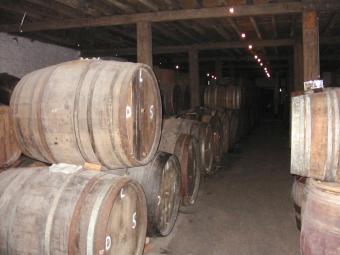 Geuze
Geuze maturing at
Cantillon brewery
A few suggestions
- Commonly available
- Mort Subite, originally brewed for the café of that name in Brussels. Sometimes still hits the mark with a distinctive flavoured Geuze although the fruit beers can be a bit on the bland side.
- Timmermans fruit beers are imported into Britain in large quantities. In recent years, the amount of lambic in the recipe has dropped so much that it's not even discernable any more. In truth, Timmermans' fruit beers taste more like alco-pops than fruit beers these days and are worth avoiding. The straight geuzes occasionally have a bit more lambic taste to them.
- An easy introduction. Someone who has never tasted geuzes will almost certainly be put off by the more extreme examples. The following provide a gentle way into the style.
- Lindemans Frambozen is a tasty raspberry beer with a lot of flavour. Quite common on draught in Paris. In truth, the raspberry flavour dominates so much that this could almost be described as an alcopop.
- Now you've got the taste:
- Oude Beersel Deliciously tasty beers. One of my favourites. Get it while you can, because sadly the brewery went out of business in 2003, so only residual stocks are around.
- Frank Boon Sells some pasteurised beers, but the un-pasteurised ones are what you need to look out for. The future of craft-brewed beers from Boon is in some doubt though, after the brewery was taken over in mid-2003 by Palm, who have already wreaked havoc at Rodenbach. Oude Kriek has a delicious 300 grammes of cherries per litre. Mariage Parfait Geuze is excellent and stronger than average for the style at 8%.
- Hanssens A geuze to fall in love with.
- Only for the initiated
- Cantillon is the only remaining traditional brewery in Brussels itself and brews geuzes so woody and sour that if they were the first of the style you tried, you'd almost certainly develop a hatred for all lambics.
Back to
top
Back to
styles

Can there be a town in Britain where you can't get a glass of
Hoegaarden? Probably the most readily available Belgian beer after the awful
Stella Artois (which in any case is actually contract-brewed in Whitbread's factories) this beer re-established the popularity of wheat beers in Belgium; they had all but died out by the mid-seventies.
Unfortunately, Hoegaarden has been dummed-down a fair bit by InBev, who are planning to close down the brewery and transfer production to their Jupille fizz-factory.
You can recognise wheat beers by the fact that they're often called
"blanche" (if from Wallonia) or
"wit" (from Flanders.)
Perhaps the greatest service Hoegaarden has rendered is to remind the British drinker that a beer that's cloudy isn't
necessarily off. The protein haze that is typical of wheat beers only disappears when they've had all the flavour filtered and pasteurised out of them.
Spices are very commonly added to Belgian wheat beers, something that would make a German brewer blanche!
A few suggestions
- Wittekerke Bizarrely named after a popular Belgian TV soap, but don't let that put you off; this is one of the most refreshing beers you could find on a hot summer's day.
- Vlaamsch Wit (also known as "Blanche des Flandres") is another tasty example of a Belgian Wheat beer.
- Brugs Tarwebier is another wheat beer that has been enjoyed on more than one occasion.
Back to
top
Back to
styles
Brown ales are a particular speciality of East Flanders, but are of course brewed all over Belgium. Beers designated as
Old Browns are (or at least should be) blends of young and old beers. They are frequently quite acidic, although not as much so as lambics.
Some brewers infuse their brown ales with fruit in a similar manner to the lambic brewers. Although the sweet/sour balance is less pronounced, some of these are very popular.
A few suggestions
- Liefmans brew very popular fruit-infused beers; they are readily recognised by being hand-wrapped in paper rather than having conventional labels. The Kriekbier is made with cherries, the Framobzenbier, which one friend of mine is unable to resist, is made with raspberries. Unfortunately these beers are normally sweetened, though not offensively so. If you get chance to sample the rare unsweetened versions (ongezoet) grab it; the difference is incredible. Liefmans brown ale is a typical example of the Oudenaarde style with a slightly sour note to the flavour.
- Charles Quint (AKA Keizer Karel) is a stronger, dryer version of the style.
Back to
top
Back To
styles
Red beers are a particular speciality of West Flanders. They get their colour from the dark malts used in their production. Like
geuzes, red beers tend to be blends of old and young brews. To make the similarities greater, they are sour, although never so sour as the most extreme
geuzes and often it is barely noticeable.
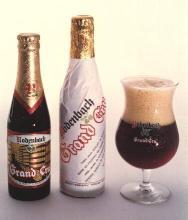
A few suggestions
- Rodenbach is undoubtedly the classic of the type. There are two brews; Klassiek and Grand Cru. If you just ask for "A Rodenbach" (Een Rodenbachje) you will be served the Klassiek, which is a blend of mature and new beer. Grand Cru is made purely from the aged beer and displays a much more complex flavour. Rodenbach Grand Cru is described by beer writer Michael Jackson as "the most refreshing beer in the world."
- Duchesse de Bourgogne probably loses a little complexity by being pasteurised, but is nonetheless a delightful, easy-drinking beer which is well worth seeking out. It can be wonderfully refshing on a hot day, as I found on holiday in Maastricht during the heatwave of 2003.
- Echt Kriekenbier (originally called Echte Kriek) brewed like Duchesse de Bourgogne by Verhaege is a cherry-infused beer which seems to have a West Flanders Red as its basis. A nice contrast between the sweetness of the cherries and the sourness of the base beer.
Back to
top
Back To
styles
Very much a Walloon speciality, particularly from the west of the
Hainault province, these beers are not at all common in Flanders. As the name suggests these are seasonal beers traditionally brewed during the cooler months of the year, to be drunk during the summer. Many
Saison brewers can trace their history back to traditional farmhouse breweries. To my palate, Saisons have a rather cloying mouth-feel, rather reminiscent of Dutch
Bok beers.
A few suggestions
- Dupont is regarded by many other brewers as the finest example of a Saison.
- Silly is a very popular and widely available Saison.
Back to
top
Back to
styles
Once upon a time, when drinking water wasn't to be trusted, every abbey brewed its own beer to sustain its monks and provide refreshment for visitors. Today, brewing is only carried out in a small number of monasteries, although many commercial brewers produce beers with monastic connections; some real, others imagined. Many of these beers are produced under license from the associated monastery, which receives a royalty on each bottle sold. Such is the commercial cachet of the abbey connection, a good many beers exist which, while trying to imply a monastic connection, actually have none.
Only beer brewed under the
direct supervision of Trappist monks may be designated as "Trappist" beer. There are currently seven such breweries, six in Belgium plus a single Trappist brewery in the Netherlands
 The Trappist brewers
The Trappist brewers
Even the most determined atheist will find the best Trappist beers impossible to resist. Whilst not exactly justifying the existence of religion, they certainly represent one of its few benefits to mankind.
- Achel An established monastic brewery until the brewing vessels were looted by the German army during World War 1, brewing restarted here in 1998. Initially, Achel beers were somewhat disappointing, but they seem to be getting better as time goes by.
- Chimay is the largest and best-known of the Trappist brewers. There is some controversy over the question of whether Chimay beers should really be designated as Trappist, since most of the brewing is carried out by non-monks these days. The beers used to be of a very high standard, but they have deteriorated quite a bit in recent years.
- Orval beer is brewed to a style very different to the other Trappist ales. Only a single beer is readily available and it is very light and hoppy.
- Rochefort while better known for its cheeses, also produces some magnificent beers. Only the Westvleteren beers surpass Rochefort beers.
- Westmalle is almost as commonly available as Chimay. The beers are well-crafted but the alcohol content can sometimes make them a little harsh on the palate.
- Westvleteren is the hardest to find and most worth seeking of the Trappist brewers. The abbey does not market or even distribute its produce. Any bar or shop wanting them has to send someone to turn up at the monastery and collect their supplies. If you visit Antwerpen, you can usually sample Westvleteren beers at the Oud Arsenaal. Their nearby shop, Den Dorstvlegel usually has bottles in stock.
- La Trappe The only Trappist brewery outside Belgium, La Trappe was for several years not recognised as a true Trappist brewery due to a mis-judged commercial tie-up, but since late 2005 this has been amended and the monks are again in charge of brewing, thus qualifying beers from the Koningshoeven monastery to qualify as Trappist.
A few suggestions
- Commonly available
- Trappists
- Chimay Rouge is so widely available that even Sainsbury's have been known to sell it. A pleasant, easy-drinking beer, it is however a little on the thin side.
- Westmalle Dubbel is a deliciously dark beer but a little lacking in subtlety.
- Abbey Beers
- Leffe Blonde (brewed by InBev) is probably the commonest abbey beer sold in Britain. Not the most exciting Belgian beer to be had, but still tasty. The less common Bruin has more character.
- Worth seeking out
- Trappists
- Wesvleteren 12 is one of my all-time favourite beers. Weighing in at 11-12% abv it isn't a beer you can drink a lot of, but the outstanding, slightly earthy flavour makes it worth trying hard to find. Only small quantities are produced, so it's a beer to grab when you find it. Westvleteren beers don't have labels on the bottles, so you can recognise this by its yellow cap - if I haven't bought it all before you get to it!
- Rochefort 10 is a strong, dark beer with loads of flavour and plenty of body. A real pleasure to drink. The Rochefort 8, at only 9.2% is also delicious and dangerously drinkable.
- Abbey Beers
- Corsendonk Pater Noster is a very tasty dark beer.
- Ename provide a nice range of abbey-style beers worth trying.
- Maredsous (8 & 10), brewed by Moortgat, who are better known for Duvel. Excellent and very tasty; possibly the best Abbey beers I've tasted.
Back to
top
Back to
styles
The "ordinary" ales of Belgium are frequently anything other than ordinary. Generally bronze or copper in colour and
relatively low in alcohol (relative to the average Belgian beer, that is) many of these ales were developed as a response to the encroachment of Pilsner-style lagers in the 1920s. Probably the most readily available is
Palm, although this isn't a particularly exciting example.
Suggestion
- De Koninck sets the standards by which other Belgian ales are judged. There may be a bar somewhere in Antwerpen where the simple request "Een bolleke, alstublieft" fails to bring forth a distinctive goblet of De Koninck, but I haven't found it yet. The brewery, a couple of miles from the city centre is surprisingly small when you consider how widely available its beers are. I have sampled bottles of De Koninck, but it only really comes into its own when served on draught. Cuvée de Koninck is a newer, stronger brew which tastes delicious on draught or from a bottle.
Back to
top
Back to
styles
This is not a designation commonly used within Belgium itself, but it is a useful way of describing a number of strong, light beers. Expect an alcohol content in the region of 8% or more and a light, almost Pilsner-like colour.
A few suggestions

- Duvel is probably the definitive beer in this category. It got its name when a brewery worker commented "it's a devil of a beer" when sampling a test brew (Duivel is the Flemish word for "devil".) This is a beer which many people like to lay down and drink when it's aged a few years, although I've never managed to resist it long enough to do that. It is a classic example of a beer whose character changes entirely when drunk with the yeast in it. Try carefully pouring about 3/4 of the bottle so that the yeast stays in the bottle, then when you've drunk that, swirl the bottle to get the yeast in suspension and pour the rest. You'll be pleasantly surprised.
- Straffe Hendrick is no longer brewed at the Halve Maan (Half Moon) brew-pub in Brugge, although tours of the old brewery still run regularly and are well worthwhile. Straffe Hedrick Blonde is a favourite of many lovers of Belgian beer.
- Delirium Tremens is a spiced 9% abv beer that will have you seeing pink elephants. That's because they feature on the bottle and glass, although it would be rather easy to drink enough of this dangerously delicious brew to see them elsewhere.
Back to
top
Back to
styles
Belgian brewers produce so many distinctive beers that it's impossible to categorise them all. Some are in styles that are restricted to a particular province, some just to a single town or are even produced by just one brewer. Some are ancient traditional styles, others have been invented in recent decades. Try as many as you can; undoubtedly you will detest some, but you will most certainly find others which delight you and make you want to come back for more.
A few suggestions
With such a wide range of styles to choose, it would be impossible to suggest representatives of all styles; these are just a few which I have found enjoyable.
- De Dolle Brouwers (The Mad Brewers) produce several distinctive beers. Oerbier (7.5%) is a favourite. Another dark, malty brew which never fails to delight. The character can vary, sometimes having a slightly sour flavour more like a brown ale.
- La Chouffe is a fairly new brewery in the Luxembourg province. Several beers are produced; all sold in 75cl champagne bottles with the distinctive bearded gnome from which the brewery gets its name on the label. McChouffe is an interesting example with Scottish inspiration.
- Hercule is a magnificent 9% stout brewed by the Walloon Brasserie Ellezelloise. Probably my favourite Wallonian beer. Another beer you couldn't drink all night, but somehow you'd like to try...
- Kwak is a freely available deep amber beer, served in a very unusual glass which is shaped rather like a small yard of ale. To keep the glass upright, it sits in a wooden stirrup. This is another beer which can be rather disappointing from the bottle, but very nice from the tap.
- Grottenbier is the latest enterprise by Pierre Celis, who founded (and later sold) Hoegaarden. As the name implies, Grottenbier is matured deep underground in caves which are just over the border from Maastricht. A dark, heavily spiced beer, I personally found it rather disappointing but other people enjoy it.
Back to
top
Back to
styles
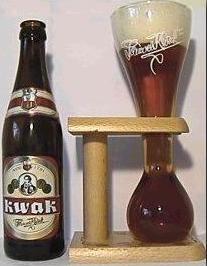
The most comprehensive guide to Belgian beers is probably Michael Jackson's
Great Beers of Belgium. The only major weakness of this book is that Jackson seems reluctant to say anything negative about any beer, which suggests to me that his association with the Confederation of Belgian Brewers may be too close for him to be regarded as a truly independent writer. Despite this, the book is highly recommended.
For "on the spot" information on drinking in Belgium, the best guide is Tim Webb's
Good Beer Guide to Belgium (published by CAMRA) which contains details of bars in every major (and many minor) town in the country, together with extensive brewery and beer listings. Tim has also recently published
Lambicland (with Chris Pollard & Joris Pattyn) which is a good guide to Lambics and the Payottenland bars they can be enjoyed in.
Tromp's Beer Traveller in West Flanders is a good guide to that particular province, written by well-known beer-tour organiser,
Simon van Tromp (Available from
the Beer Traveller site)
Classic Beer Styles: Lambic by
Jean Xavier Guinard is a good read if like me you fall in love with this particular beer style.
Zythos is the Belgian Equivalent of CAMRA.
The Belgian Beer Pub Map will help you find some of the best beer bars in Belgium.
All About Geuze is a useful reference to the lambic family.
Beer Paradise Belgium is the home of the Confederation of Belgian Brewers.
HORAL is the umbrella organisation for Lambic brewers.
Beer Traveller is
Simon van Tromp's travel company, organising beer tours to Belgium and beyond, mainly from East Anglia.
Michael Jackson has his own site as well, covering not just Belgium but many other countries too.

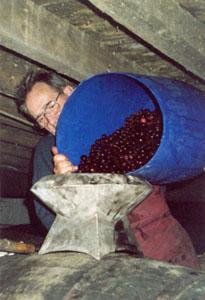
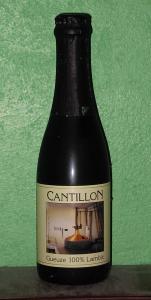


 Brown ales are a particular speciality of East Flanders, but are of course brewed all over Belgium. Beers designated as Old Browns are (or at least should be) blends of young and old beers. They are frequently quite acidic, although not as much so as lambics.
Brown ales are a particular speciality of East Flanders, but are of course brewed all over Belgium. Beers designated as Old Browns are (or at least should be) blends of young and old beers. They are frequently quite acidic, although not as much so as lambics.
 The Trappist brewers
The Trappist brewers